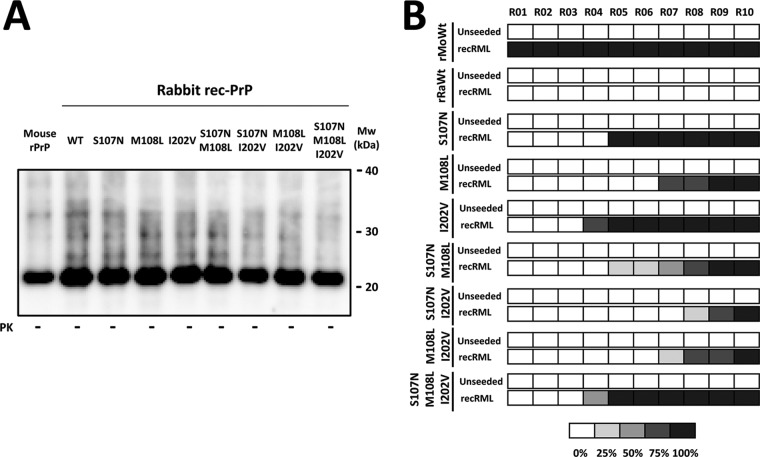FIG 6.
Multiple mouse rec-PrP substitutions in rabbit rec-PrP do not reduce the interspecies transmission barrier compared to that with rabbit rec-PrP with single substitutions. (A) Different recPMCA substrates containing single, double, and triple mutant rabbit rec-PrPs were compared by Western blotting. PrP amounts were adjusted by dilution with Prnp0/0 mouse brain homogenate to reduce the variability. The membrane was developed with monoclonal antibody SAF84 (1:400). All samples showed similar amounts of recombinant PrP in the substrates. (B) Diagram of rec-PrPres generation over the course of serial in vitro propagation of the rabbit recombinant single, double, and triple mutant rec-PrPs, using recRML as the seed. Generation of rec-PrPres was evaluated by PK digestion and Western blotting (with monoclonal antibody SAF84) for each recPMCA round (rounds 1 to 10). Wild-type rabbit (rRaWt) and wild-type mouse (rMoWt) rec-PrP-containing substrates were included as negative and positive controls, respectively. The percentages of tubes showing PK-resistant misfolded rec-PrP are indicated in grayscale according to the legend. The triple mutant rabbit rec-PrP construct did not show enhanced misfolding ability compared to that of single mutant rec-PrPs. The rabbit rec-PrPs with double substitutions gave rise to rec-PrPres in later rounds than those for rabbit rec-PrPs with single substitutions, especially the I202V variant, suggesting that single substitutions combined do not act in a cooperative manner to reduce the transmission barrier.

